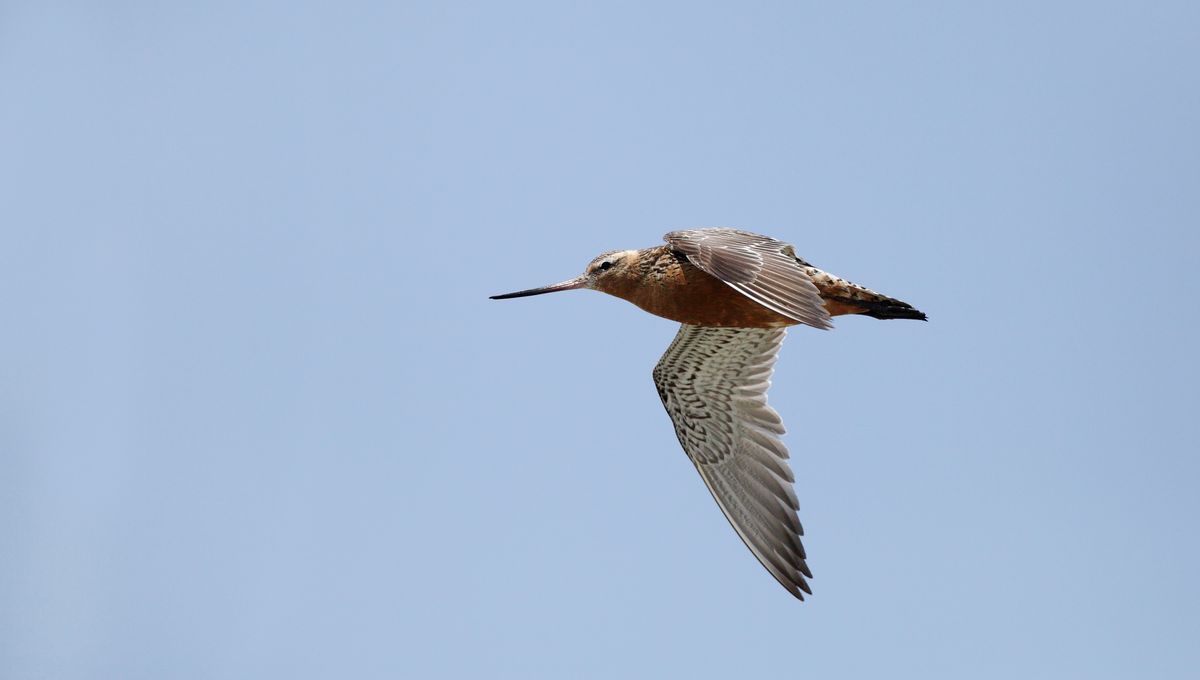
A bar-tailed godwit (Limosa lapponica) has been recorded flying 13,560 kilometers (8,435 miles) between Alaska and Ansons Bay, Tasmania, the longest non-stop migratory flight ever measured. The odyssey is not only a demonstration of birds’ staggering capabilities, but has given scientists and environmentalists a chance to highlight the threats to these winged adventurers’ survival.
Godwits are one of hundreds of bird species that breed during the brief but bountiful Alaskan summer, before escaping the bitter winter. Some go only as far as the tropics, but others go as far as Australia or New Zealand. It’s an epic journey for any bird, but the godwits don’t even stop on route.
The Pūkorokoro Miranda Naturalists’ Trust have been using satellite trackers to monitor the round trip of the New Zealand contingent for years. A 13,050 km (8,435 miles) record was set last year. Earlier this year however, a tracker was placed on a juvenile born in the Alaskan spring.
Instead of heading for New Zealand, however, this bird made a sharp right turn in the Tasman Sea to land in Tasmania. The flight took 11 days.
Sean Dooley of BirdLife Australia told IFLScience the baueri godwit subspecies has a wide range over coastal eastern Australia, but Tasmania is about as far from their breeding grounds as they go. Consequently, if the new record is ever broken, it’s unlikely to be by much.
Nevertheless, this bird probably wasn’t some lone hero. Godwits make the journey in substantial flocks, both for safety from predators and so they can take turns cruising in each other’s wake, like cyclists in a peloton.
Curiously, while most of the godwits fly south in a single journey, they’re one of many species that take a longer route back up the coast of Asia, stopping in the Yellow Sea to refuel. Development in the area, particularly damage to coastal flats, has had a devastating effect on migratory bird species. The baueri godwits are doing relatively well, classified only as threatened. However, their close relatives the menzbieri, which migrate from Siberia to Northwestern Australia, are considered critically endangered.
Although the Ramsar Convention is supposed to protect wetlands used by migratory birds, BirdLife Australia is campaigning to save one of the L. lapponica baueri’s prime Australian territories, under threat from a proposed development.
Satellite tracking has transformed our knowledge of bird migrations. “We used to think they stopped on route,” Dooley told IFLScience. “But there are not many places to land” mid-Pacific. The record breaker did fly over Vanuatu, however, but Dooley noted that the lands the birds cross on route, “Are generally not good feeding places for these birds.” However, godwits have been spotted on Pacific Islands, presumably gathering strength to restart the journey.
Trackers can’t answer the great mystery of how godwits (like other migratory species) know which way to go. Whether the record breaker was always heading for Tasmania, or if it got diverted from New Zealand, is similarly mysterious. “They’re definitely responsive to atmospheric conditions,” Dooley said. “We’ve seen some heading into Moreton Bay and encountering bad weather and backtracking a long way.”
The birds feed on bristleworms and molluscs living in the mud of coastal wetlands, packing on so much fat that they must reduce the size of their digestive organs when ready to fly. Adults leave Alaska 4-6 weeks before the juveniles. Whatever the benefit to those leaving early, those weeks with less competition for food probably give the young birds the chance to fuel up for the epic flight, Dooley noted.
The timing was ideal for the bar-tailed godwit’s campaign in the fiercely fought New Zealand Bird of the Year contest.
H/T The Guardian.
Source Link: Bird Makes Record-Breaking Flight From Alaska To Tasmania Without Landing